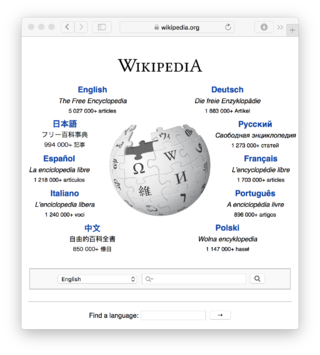
Wiki software is collaborative software that runs a wiki, which allows the users to create and collaboratively edit pages or entries via a web browser. A wiki system is usually a web application that runs on one or more web servers. The content, including previous revisions, is usually stored in either a file system or a database. Wikis are a type of web content management system, and the most commonly supported off-the-shelf software that web hosting facilities offer.
Moodle is a free and open-source learning management system written in PHP and distributed under the GNU General Public License. Moodle is used for blended learning, distance education, flipped classroom and other online learning projects in schools, universities, workplaces and other sectors.

Tiki Wiki CMS Groupware or simply Tiki, originally known as TikiWiki, is a free and open source Wiki-based content management system and online office suite written primarily in PHP and distributed under the GNU Lesser General Public License (LGPL-2.1-only) license. In addition to enabling websites and portals on the internet and on intranets and extranets, Tiki contains a number of collaboration features allowing it to operate as a Geospatial Content Management System (GeoCMS) and Groupware web application.
The following tables compare general and technical information for many wiki software packages.

Mantis Bug Tracker is a free and open source, web-based bug tracking system. The most common use of MantisBT is to track software defects. However, MantisBT is often configured by users to serve as a more generic issue tracking system and project management tool.

Joomla, also spelled Joomla! and sometimes abbreviated as J!, is a free and open-source content management system (CMS) for publishing web content on websites. Web content applications include discussion forums, photo galleries, e-Commerce and user communities and numerous other web-based applications. Joomla is developed by a community of volunteers supported with the legal, organisational and financial resources of Open Source Matters, Inc.
Notable issue tracking systems, including bug tracking systems, help desk and service desk issue tracking systems, as well as asset management systems, include the following. The comparison includes client-server application, distributed and hosted systems.
EGroupware is free open-source groupware software intended for businesses from small to enterprises. Its primary functions allow users to manage contacts, appointments, projects and to-do lists. The project releases its software under the terms of GNU General Public License (GPL).

TCPDF is a free and open source software PHP class for generating PDF documents. TCPDF is the only PHP-based library that includes complete support for UTF-8 Unicode and right-to-left languages, including the bidirectional algorithm.
In FOSS development communities, a forge is a web-based collaborative software platform for both developing and sharing computer applications.
Redmine is a free and open source, web-based project management and issue tracking tool. It allows users to manage multiple projects and associated subprojects. It features per project wikis and forums, time tracking, and flexible, role-based access control. It includes a calendar and Gantt charts to aid visual representation of projects and their deadlines. Redmine integrates with various version control systems and includes a repository browser and diff viewer.

Chamilo is a free software e-learning and content management system, aimed at improving access to education and knowledge globally. It is backed up by the Chamilo Association, which has goals including the promotion of the software, the maintenance of a clear communication channel and the building of a network of services providers and software contributors.

Foswiki is an enterprise wiki, typically used to run a collaboration platform, knowledge base or document management system. Users can create wiki applications using the Topic Markup Language (TML), and developers can extend its functionality with plugins.
AMPPS is a solution stack of Apache, MySQL, MongoDB, PHP, Perl and Python for Windows NT, Linux and macOS. It comes with 419 PHP web applications, over 1000 PHP classes and 6 versions of PHP. AMPPS is created by Softaculous Ltd. a company founded in 2009 which makes the Softaculous Auto installer. AMPPS is used to develop on PHP, MySQL applications like WordPress, Joomla, and Drupal.
YAML is a cross-browser CSS framework. It allows web designers to create a low-barrier website with comparatively little effort. Integrations of the YAML layouts have been created for various content management systems. These include WordPress, LifeType, TYPO3, Joomla, xt: Commerce and Drupal.

H5P is a free and open-source content collaboration framework based on JavaScript. H5P is an abbreviation for HTML5 Package, and aims to make it easy for everyone to create, share and reuse interactive HTML5 content. Interactive videos, interactive presentations, quizzes, interactive timelines and more have been developed and shared using H5P on H5P.org. H5P is being used by 17 000+ websites. In June 2018 the core team announced that H5P will be supported financially by the Mozilla Foundation within the MOSS program.

DBeaver is a SQL client software application and a database administration tool. For relational databases it uses the JDBC application programming interface (API) to interact with databases via a JDBC driver. For other databases (NoSQL) it uses proprietary database drivers. It provides an editor that supports code completion and syntax highlighting. It provides a plug-in architecture that allows users to modify much of the application's behavior to provide database-specific functionality or features that are database-independent. This is a desktop application written in Java and based on Eclipse platform.








